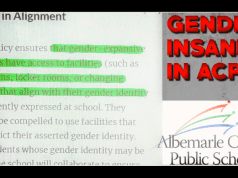A 32-year reign of engineered, single-seat black representation on Charlottesville’s City Council crashed to a screeching halt on Sunday with the early morning release of results in Charlottesville’s Democratic Firehouse Primary. In their wake, racial turmoil and long overdue electoral reform increasingly are likely.
Colette Blount, assumed successor to the “black crown” on Charlottesville’s all Democrat and historically white City Council, has lost her electoral bid, reportedly finishing fifth in a field of seven candidates. Only the top three vote getters can appear on the November general election ballot where the finalized Democrat slate is predestined for victory.
Blount’s defeat puts Charlottesville’s primarily white Democrat committee and the city’s black community at odds, threatening an uneasy alliance that has existed between the two entities since the early 1980s.
Charles Barbour was Charlottesville’s first black City Councilor. Elected in 1970, he served two terms. In 1978, black Democrat, James Hicks, was defeated in his attempt to follow Barbour leaving a two-year period of no black representation on Charlottesville’s City Council. Although Hicks would have been victorious running solely in either of the city’s two black precincts, Firehouse (Tonsler) and Lane (Carver), Charlottesville’s at-large voting scheme effectively nullified Hicks’s precinct victories when votes from white areas of the city were tallied.
During the ensuing years, seeking a fairer environment within which to compete, the Charlottesville NAACP called for ward-based elections to replace the city’s racially exclusive at-large system. Led by the late Virginia Carrington, the NAACP relentlessly petitioned then mayor, Frank Buck, to move the city from at-large elections (which had been dismantled by the United States Department of Justice in many other Southern cities during the 1960s and 1970s) to ward-based elections.
Buck and his predominantly white Democrat council cohorts reluctantly agreed to place the issue of moving toward ward-based elections on the November 1981 ballot as an advisory referendum. The measure passed in 6 of the city’s 8 precincts, with overwhelming support in the city’s two historically black precincts, Firehouse and Rose Hill (Carver). But there was a significant under-vote on the measure, as the Charlottesville Democratic Committee did not place the referendum on their sample ballot—knowing well that omission would yield greatly diminished voter participation. When Carrington and the NAACP pressed Mayor Buck to act on the referendum’s results, he rejected the obvious call for change, disingenuously claiming that the vote was “not decisive enough.”
Six months later, in May 1982, Buck put the same advisory referendum back onto the ballot—this time, a ballot on which Buck himself was a candidate for reelection to the City Council. He and other establishment Democrats actively campaigned against the referendum. Concurrently, Charlottesville’s white Democrats also colluded to divide the NAACP’s support for wards by offering perks to strategically recruited members of the city’s black community in what later was termed a “system of patronage.” Under this proposal the Charlottesville Democrats “guaranteed” in perpetuity one black seat on the five-member council in exchange for voting “cooperation” from the elected black Democrat in issues of importance to (white) Party leadership.
Following Buck’s backroom deal, the second ballot referendum was defeated in six of the city’s eight precincts: a mirror opposite of the previous ballot result. The NAACP membership split over the outcome, and the organization was substantially weakened. Buck, meanwhile, was victorious in maintaining lock-fisted, white control of the Charlottesville Democratic Committee.
From the deal’s inception through today, there has been an uninterrupted succession of one, and only one sitting black Democrat at a time on Charlottesville’s City Council:
[table id=8 /]
In addition, the Charlottesville Democratic Committee never has run a 2nd black candidate while one currently was serving, fearing that a powerful black voting-bloc would emerge to challenge the white Democrat establishment.
As the burden of assenting to demands of the Party became unbearable for solicited black men, fewer and fewer appeared interested in carrying the mantle of Charlottesville’s token black councilor. With a dearth of available men, the city’s Democrat machine then began recruiting women for the black seat. Unlike their male predecessors, both Kendra Hamilton and Holly Edwards each served only a single term, adding complexity to Democrats’ recruitment efforts and their ongoing racial manipulation scheme. Today, finding any black candidate willing to capitulate to the city’s Democrat Party bosses has become a near impossibility. In the absence of a willing mark, Party leaders appear intentionally to have let the “bargain” lapse.
When Colette Blount emerged as the only black Democrat candidate in the 2011 election cycle, nerves began to jitter. The establishment wing of the party—headed by Jim Nix and Tom Vandever—worried that Blount would be independent of Party dictates since she had aligned herself with Mayor Dave Norris’s interests and did not seek counsel and blessing from these elders. Of particular concern was Blount’s pro-Norris-plan position on the community water supply, which was diametrically opposed to that of Nix and Vandever, et al.
Blount’s candidacy received its death-blow when establishment Democrats, Kay Slaughter (former Mayor) and Kristen Szakos (current councilor) endorsed only two candidates, Kathy Galvin and Satyendra Huja, for the three open seats council seats, thus backstabbing their reputedly ideologically aligned co-candidate, Paul Beyer. Establishment Democrats needed to secure only two seats to maintain their control of council (Huja and Galvin along with incumbent Szakos will form a majority bloc), thus Beyer was rendered superfluous.
While these racially motivated non-endorsements were the unofficial abrogation of Beyer’s campaign, they represented the eradication of Blount’s. Although refusing to directly challenge the black candidate’s legitimacy, through calculated omission, Szakos and Slaughter secretly signaled the acceptability of establishment Democrats’ deprecation of Colette Blount in their ballot rankings.
The Democrats’ neoteric implementation of Instant Runoff Voting (IRV)—which allowed every voter to vote for every candidate, through a ranking system—also was a culprit in Blount’s electoral demise. In previous primary elections, most Democrats knew that it was in the Party’s best interest for the chosen black candidate to be the top vote getter, and thus, the designee typically received the most votes. IRV changed the voting dynamic drastically. As every voter now voted for every candidate through a ranked ballot, the black candidate was now one-of-many votes on every ballot instead of one-of-a-select-few votes on (nearly) every ballot; mechanically and fundamentally, IRV undermined Blount’s chances. Since casting a vote for Blount inherently was a function of every ballot, there was no overriding imperative to rank her highly. In fact, many Democrats, angry with Norris and his slate, ranked Blount in the bottom half of their ballots, ultimately placing her fifth in a field of seven candidates.
White Charlottesville Democrats received the Slaughter/Szakos directive loud and clear—as demonstrated by their voting patterns—and resultingly, both Blount and Beyer were sacrificed at the altar of Democrat machine politics.
But the racial hangover from the Democratic Firehouse Primary does not end with Colette Blount’s repudiation. An intra-party challenge from Llezelle Dugger and Pam Melampy for Paul Garrett’s long held Clerk of Court seat saw Garrett, who is black, ejected from the position he’s occupied since his initial appointment to the post over 30-years ago—a date not coincidental to the inception of the Charlottesville Democrats’ 32-year-old compromise with the city’s black community. Garrett’s ouster will heap gasoline onto an already raging fire of racial discontent within Charlottesville’s Democrat Party.
Major electoral changes are possible and necessary in the aftermath of the Charlottesville Democrats disastrous firehouse primary. Non-partisan elections, implementation of ward or district-based elections, and a move toward a directly elected mayor openly are being discussed by Democrats who most recently had not considered such remedies necessary or even palatable.
In a city long dominated by white Democrats who have refused to equitably share the power of governance, their corrupt patronage “solution” to Charlottesville’s black “problem” eventually had to fall under its own encumbrance. And now it has. Sadly, it took 32 years. But finally, and thankfully, Charlottesville’s racially engineered political chickens have come home to roost.









White Charlottesville Democrats received the Slaughter/Szakos directive loud and clear—as demonstrated by their voting patterns
Demonstrated, eh? Could you show us the evidence for that? No you can’t. Nor can you demonstrate that race was the reason she didn’t receive white Democratic endorsements.
Read the Daily Progress piece. That would suggest that Blount lost by allying herself to Mayor Norris and that she quite possibly would have lost in the old convention system too.
Dear Rob, What happened to the era of “post-racial
politics”? Could this instant runoff voting primary
be an example of this? Is there any evidence that
Colette Blount or her supporters attempted to mobilize
black voters in support of her candidacy? Rick Turner
of the N.A.A.C.P. seems to think this was not the case
in his comments in an article in THE HOOK by Lisa Provence.
[…] in attempt to out America-hate fellow travelers at Charlottesville’s August 20 Democrat Firehouse Primary, the self-described “Urban Turban”—a candidate for reelection to Charlottesville’s City […]
The article does an excellent job in capturing the racial overtones of local politics in Charlottesville. However, I would have appreciated seeing the election data, and stacking up the IRV results against a hypothetical at-large-style result set for the same race, to see if IRV is an improvement (my studies have shown that it is in fact a huge improvement)
Because I am troubled by this assertion: “Mechanically and fundamentally, IRV undermined Blount’s chances. Since casting a vote for Blount inherently was a function of every ballot, there was no overriding imperative to rank her highly.”
I think blaming this voting system is wrongheaded, for IRV has historically shown to improve minority representation — last year, for instance, the city of Oakland, CA elected its first-ever Asian-American and female mayor using IRV. Indeed, fair representation of minorities (whether racial or ideological) is often the primary reason for its adoption in municipal elections. For, you never grappled with this: how would she have fared under the old at-large system? I would argue: even worse. If she was the fifth choice on many/most ranked ballots, then how would she be more than a blip for a few open seats on a conventional ballot? Being ranked fifth does not mean IRV failed her, it meant she did something politically foolish (like align with Norris), and suffered the consequences.
IRV is an evolution in election methods that could open up our system to previously disenfranchised groups. It is imperative that citizens learn about it and understand how it improves upon our primitive, simplistic “plurality” system to better represent ALL voters’ preferences.
Adam,
The story was not meant to be an indictment of IRV, rather, in this instance, how it led to the defeat of an historically favored candidate. This was due to Charlottesville’s long standing racial election manipulation, chronicled here in greater detail.
If you read the piece carefully you’ll see that I did compare this candidate’s chances under the old system vs. the new system. I contend that Collette Blount may have been victorious under a standard ballot, and I provided analysis to that point.
Unfortunately, the local Democrat establishment sees IRV as useful tool for their primary, but not for the general election. Outside of The Schilling Show, there has been no public discussion of implementing IRV in local general elections.
Thanks for weighing in.
The article does an excellent job in capturing the SHAMEFUL racial connotations of local politics in Charlottesville. It is SHAMEFUL for both Blacks and Whites that in the year 2011 an election is first, decided behind closed doors {when do the people in the community’s votes count}, second, based on the color of one’s skin –v- their political characteristics. What are you teaching the children in the community? Are they expected to live there the rest of their lives, because the rest of the world does not live like this….or should I say the racism is not as exposed as this……..Racism is alive SHAMFULLY in the USA, however those of you that participate one way or another ought to be ashamed of yourselves. {of course you’re not or this would not be going on}. And for the paper to write the heading as they did, oh my goodness, I was blown away. My mother and I were traveling through and stayed at a hotel in your community. What a beautiful community, and a beautiful sight to see that God has blessed you SHAMEFUL people with. It is a SHAME to read about the blatant racism that goes on in your community. SHAME ON YOU ALL!!!